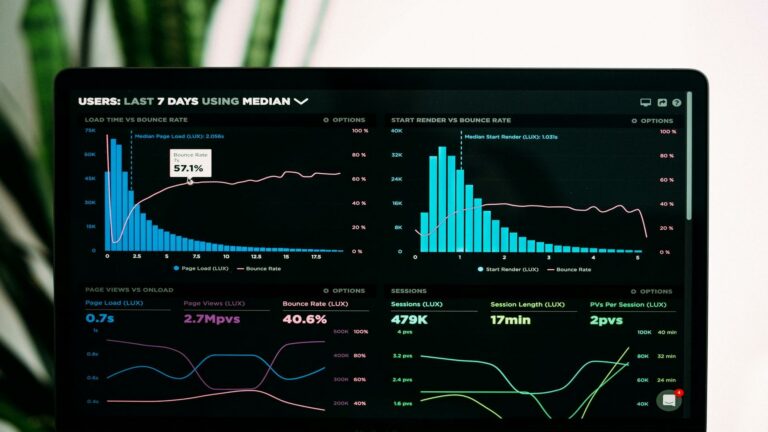Create Personalized Website Experiences: The Ultimate Guide
Creating Personalized Website Experiences: A Comprehensive Guide
In today’s digital landscape, creating personalized website experiences has become crucial for businesses looking to stand out and engage their audience effectively. At Web Design London, we specialize in crafting tailored online experiences that resonate with your target audience and drive conversions. This comprehensive guide will walk you through the process of creating personalized website experiences that can transform your online presence.
Understanding the Importance of Personalization
Personalization is more than just a buzzword; it’s a powerful strategy that can significantly impact user engagement and conversion rates. By delivering content tailored to individual user preferences and behaviors, you can create a more meaningful and memorable experience for your visitors. Utilizing content links effectively can help you build a more interconnected and personalized user journey.
Key Elements of Personalized Website Experiences
- Dynamic Content: Adapt your website’s content based on user behavior, preferences, and demographics.
- Personalized Recommendations: Suggest products, services, or content that align with the user’s interests and past interactions.
- Customized User Interfaces: Tailor the layout and design elements to suit individual user preferences.
- Targeted Messaging: Craft personalized messages and calls-to-action that resonate with specific user segments.
Implementing Personalization Strategies
To create truly personalized website experiences, consider implementing the following strategies:
- Data Collection and Analysis: Gather user data through various touchpoints and analyze it to gain insights into user behavior and preferences.
- Segmentation: Divide your audience into distinct segments based on shared characteristics or behaviors.
- Content Mapping: Create a diverse range of content that caters to different user segments and stages of the customer journey.
- A/B Testing: Continuously test and refine your personalization efforts to optimize their effectiveness.
One effective way to implement personalization is by leveraging various content sources to create a rich and diverse user experience. This approach allows you to tailor content based on user preferences and behavior, ensuring a more engaging and relevant website experience.
Tools and Technologies for Website Personalization
To streamline the process of creating personalized website experiences, consider utilizing the following tools and technologies:
- Customer Data Platforms (CDPs)
- AI-powered recommendation engines
- Content Management Systems (CMS) with personalization features
- Analytics tools for tracking user behavior and preferences
By integrating these tools effectively, you can create a seamless personalization ecosystem that adapts to user needs in real-time.
Measuring the Success of Your Personalization Efforts
To ensure the effectiveness of your personalized website experiences, it’s crucial to track and measure key performance indicators (KPIs) such as:
- Engagement rates
- Conversion rates
- Average session duration
- Customer lifetime value
Regularly analyzing these metrics will help you refine your personalization strategies and optimize your website for better performance.
By following this guide and implementing these strategies, you can create personalized website experiences that truly resonate with your audience, driving engagement, loyalty, and conversions. Remember, personalization is an ongoing process that requires continuous refinement and optimization to stay ahead in the competitive digital landscape.
Why Personalized Website Experiences Matter
Why Create Personalized Website Experiences?
In today’s digital landscape, creating personalized website experiences has become crucial for businesses looking to stand out and engage their audience effectively. Let’s explore the key reasons why personalization is essential:
- Improved User Engagement: Personalized content keeps visitors on your site longer, as they find relevant and tailored information that resonates with their interests and needs.
- Higher Conversion Rates: Tailored experiences can lead to increased sales and sign-ups. By presenting users with content that aligns with their preferences, you’re more likely to guide them towards desired actions.
- Enhanced Customer Loyalty: Personalization builds stronger connections with your audience. When users feel understood and valued, they’re more likely to return and become loyal customers.
- Competitive Advantage: Stand out in a crowded market with unique user experiences. Customizing content sources and delivery methods can set your website apart from competitors.
- Improved User Experience: By tailoring content to individual preferences, you create a more seamless and enjoyable browsing experience, reducing friction and increasing satisfaction.
- Data-Driven Insights: Personalization efforts generate valuable data about user behavior and preferences, allowing you to continually refine and improve your website strategy.
By implementing personalized experiences, you not only cater to your users’ specific needs but also create a more dynamic and engaging website that drives better results for your business.
Best Practices to Create Personalized Website Experiences
Creating Personalized Website Experiences: Best Practices
In today’s digital landscape, creating personalized website experiences has become crucial for engaging users and driving conversions. By tailoring content, design, and functionality to individual preferences, you can significantly enhance user satisfaction and loyalty. Here are some best practices to consider when implementing personalization on your website:
- Respect User Privacy: Always be transparent about data collection and use. Clearly communicate your privacy policies and obtain explicit consent for data collection. This builds trust and ensures compliance with regulations like GDPR.
- Balance Personalization and Functionality: While personalization can greatly enhance user experience, it’s essential not to sacrifice usability. Ensure that your website remains intuitive and easy to navigate for all users, regardless of the level of personalization applied.
- Maintain Brand Consistency: Personalized elements should seamlessly integrate with your overall brand identity. Use consistent color schemes, typography, and messaging to create a cohesive experience that reinforces your brand values.
- Provide Opt-Out Options: Empower users by allowing them to choose their level of personalization. Implement easy-to-use controls that enable users to adjust their preferences or opt-out of personalized experiences altogether.
- Focus on Value: Personalization should primarily aim to enhance the user experience, not just push sales. Provide relevant content, recommendations, and features that genuinely benefit the user and address their specific needs or interests.
- Leverage Data Responsibly: Utilize user data responsibly to inform your personalization strategies. Analyze user behavior, preferences, and feedback to continuously refine and improve the personalized experience.
- Implement Progressive Profiling: Instead of overwhelming users with lengthy forms, use progressive profiling to gather information gradually over time. This approach allows you to build comprehensive user profiles while minimizing friction.
- Optimize for Multiple Devices: Ensure that your personalized experiences are consistent and optimized across various devices and screen sizes. Mobile responsiveness is particularly crucial in today’s mobile-first world.
By implementing these best practices, you can create personalized website experiences that not only meet user expectations but also drive engagement, conversions, and long-term customer loyalty. Remember, personalization is an ongoing process that requires continuous testing, analysis, and refinement to achieve optimal results.
Tools and Technologies for Website Personalization
Creating Personalized Website Experiences
At Web Design London, we leverage a variety of cutting-edge tools and technologies to create personalized website experiences that engage visitors and drive conversions. Our approach combines data-driven insights with creative design to deliver tailored content that resonates with each user.
Key Tools for Website Personalization
- Customer Data Platforms (CDPs): We utilize CDPs to create a unified view of customer data, enabling us to build comprehensive user profiles for more accurate personalization.
- Personalization Engines: Our team employs sophisticated personalization engines to automate content delivery based on user data, ensuring that each visitor receives a tailored experience relevant to their interests and behaviors.
- A/B Testing Tools: We continuously refine our personalization strategies through rigorous A/B testing, allowing us to optimize user experiences and improve conversion rates.
- Heat Mapping Software: By implementing heat mapping tools, we gain valuable insights into user behavior on your site, helping us identify areas for improvement and enhance user engagement.
- AI-Powered Recommendation Systems: We integrate intelligent product and content suggestion algorithms to provide users with personalized recommendations, increasing time on site and cross-selling opportunities.
Our expertise in these advanced technologies allows us to implement sophisticated personalization strategies that drive tangible results for your business. By creating a more relevant and engaging user experience, we help you build stronger connections with your audience and achieve your digital goals.
To learn more about how we can help you create personalized website experiences that set your brand apart, contact our team of experts today.
Case Studies: Successful Personalized Website Experiences
Real-World Examples of Personalized Website Experiences
Creating personalized website experiences has become crucial for businesses looking to engage their audience effectively. Let’s explore some compelling examples of how Web Design London has helped businesses achieve this goal:
- Dynamic Content Based on User Behavior: By implementing advanced tracking and analytics, websites can display content tailored to each user’s browsing history and preferences. This approach significantly enhances content integration and relevance.
- Location-Based Customization: Utilizing geolocation data, websites can offer location-specific content, promotions, and services, creating a more relevant experience for visitors from different regions.
- Personalized Product Recommendations: E-commerce sites can leverage AI algorithms to analyze user behavior and purchase history, presenting personalized product suggestions that increase conversion rates.
- Adaptive User Interfaces: Websites can adjust their layout and navigation based on user preferences and device types, ensuring optimal usability across various platforms.
- Customized Content Delivery: By implementing URL addressability, businesses can deliver specific content pieces directly to users, enhancing the overall browsing experience.
These personalization strategies not only improve user engagement but also contribute to higher conversion rates and customer loyalty. By leveraging advanced web design techniques and content integration tools, businesses can create unique, tailored experiences that resonate with their target audience.
The Future of Personalized Website Experiences
Creating Personalized Website Experiences: The Future of Web Design
As technology continues to evolve, the ability to create personalized website experiences is becoming increasingly sophisticated. This shift towards tailored user interactions is revolutionizing the way businesses engage with their audience online. At Web Design London, we’re committed to staying ahead of these trends to provide our clients with cutting-edge personalization solutions.
Let’s explore some of the exciting trends shaping the future of personalized web experiences:
- Voice-Activated Personalization: With the rise of smart speakers and voice assistants, websites are adapting to provide tailored experiences for voice search. This technology allows users to interact with websites hands-free, creating a more accessible and convenient browsing experience. Voice-activated ads are also emerging as a powerful tool in digital marketing, offering a new way for brands to connect with consumers.
- Augmented Reality (AR) Integration: AR is transforming how users interact with websites by overlaying digital information onto the real world. This technology enables personalized, immersive experiences that can significantly enhance user engagement and product visualization. For example, furniture retailers can allow customers to see how items would look in their own homes before making a purchase.
- Emotional AI: Advanced algorithms are now capable of analyzing user behavior and sentiment to adapt content in real-time. This emotional intelligence allows websites to respond to users’ moods and preferences, creating a more empathetic and engaging browsing experience. Voice-activated AI is playing a crucial role in this development, shaping consumer behavior in the digital age.
- Cross-Channel Personalization: As users interact with brands across multiple devices and platforms, creating a seamless, personalized experience across all touchpoints is becoming essential. This approach ensures consistency and continuity in the user journey, from social media to email marketing and website interactions.
Implementing these personalization strategies can significantly improve user engagement, conversion rates, and customer loyalty. However, it’s crucial to balance personalization with privacy concerns and ensure transparency in data collection and usage.
At Web Design London, we’re excited about the potential of these emerging technologies to create more engaging and effective websites. By staying at the forefront of these trends, we help our clients deliver exceptional, personalized experiences that resonate with their target audience and drive business growth.
How Web Design London Can Help You Create Personalized Website Experiences
Creating Personalized Website Experiences
Creating truly personalized website experiences requires expertise, technology, and a deep understanding of user behavior. At Web Design London, we offer a comprehensive approach to deliver tailored online experiences that resonate with your audience and drive results.
Our Personalization Services
- Custom Website Design: We craft unique, brand-aligned designs that seamlessly integrate personalization features, ensuring a cohesive and engaging user experience.
- Data-Driven Strategies: By leveraging advanced analytics, we inform personalization decisions that target user preferences and behaviors effectively.
- Advanced Technology Integration: We implement cutting-edge personalization tools and content management systems to create dynamic, responsive websites.
- Ongoing Optimization: Our team continuously refines your personalized experiences through A/B testing and user feedback analysis.
- Comprehensive Support: From initial strategy development to implementation and beyond, we provide end-to-end support for your personalization journey.
The Power of Personalization
Personalized website experiences go beyond simple customization. They involve integrating content from various sources to create a unified, tailored experience for each visitor. This approach can significantly enhance:
- User engagement and time spent on site
- Conversion rates and lead generation
- Customer loyalty and repeat visits
- Overall user satisfaction and brand perception
Our team of experts is dedicated to helping you harness the full potential of website personalization. By combining our design expertise with data-driven insights and advanced technology, we create personalized content experiences that truly resonate with your target audience.
Getting Started
Ready to transform your website into a personalized hub for your visitors? Contact Web Design London today to discuss how we can elevate your online presence with tailored, engaging experiences that drive real business results.
Conclusion: Transform Your Online Presence with Personalization
Creating Personalized Website Experiences
In today’s digital landscape, creating personalized website experiences has evolved from a luxury to a necessity. By implementing tailored content and user interfaces, businesses can significantly enhance user engagement and drive conversions. Leveraging content links allows for dynamic content delivery, ensuring that each visitor receives a unique and relevant experience.
To create effective personalized experiences:
- Collect and analyze user data: Utilize analytics tools to gather insights on user behavior and preferences.
- Implement dynamic content: Use URL addressability to serve tailored content based on user attributes.
- Optimize for various devices: Ensure your website adapts seamlessly across different screen sizes and platforms.
- Continuously test and refine: Regularly assess the effectiveness of your personalization strategies and make data-driven improvements.
By partnering with experts like Web Design London, you can transform your website into a powerful tool that speaks directly to each visitor. Remember, personalization is an ongoing journey. As you gather more data and insights, your ability to create personalized website experiences will continue to improve, leading to stronger relationships with your audience and better business outcomes.
To further enhance your personalization efforts, consider integrating content from various sources, such as SharePoint, to provide a rich and diverse user experience. This approach allows you to leverage existing content repositories and create a more comprehensive personalized journey for your visitors.
Ready to take your website to the next level with personalization? Contact Web Design London today, and let’s create a website experience that truly resonates with your audience, driving engagement and achieving your business goals.













